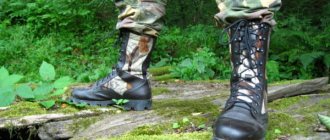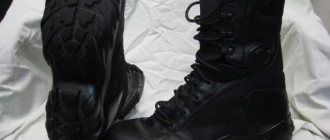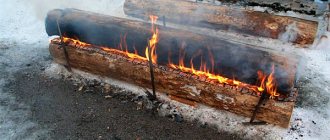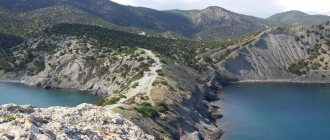Getting your feet wet while hiking is not very pleasant, but sooner or later it happens to everyone. You often have to walk through marshy areas or ford streams. In such conditions, wet shoes look quite natural.
However, this does not mean that you will have to continue the rest of the way or rest at a rest stop in wet shoes. To maintain your health and comfort on further journeys, you will definitely have to dry it. In this article we will tell you how to properly dry your boots while hiking and look at the most effective ways to help you do this.
Using socks/towel
In this case, as the name of the item implies, socks or a microfiber towel are used as an absorbent (an object that absorbs moisture). We put a dry sock on the foot, then a shoe, pull the sock out, wring it out and repeat all the steps again. If possible, periodically dry your socks over a fire/heating pad (be careful!).
If you have a microfiber towel, simply place it in your boot for a couple of minutes, then pull it out, wring it out and repeat the procedure. The disadvantage of this method is that the towel can absorb not only moisture, but also unpleasant odors from shoes, so we recommend for such purposes only using a towel that you really don’t mind.
Campfire
It is rightfully considered one of the most popular methods among tourists, however, it is also the most dangerous . We strongly do not recommend using this method, or at least taking appropriate precautions and being extremely careful!
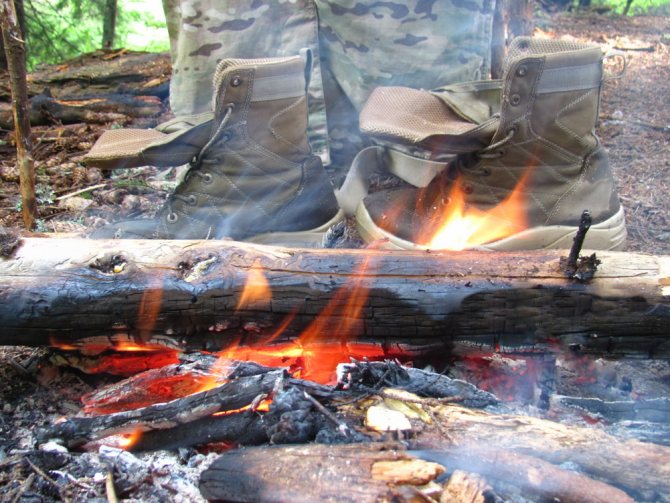
Not every shoe can withstand this type of drying. Most modern models of boots made of synthetic fabrics can easily “sit down,” lose some of their properties, burn out, or even burn out entirely if some simple rules are not followed.
Shoes can only be dried in your hands . When leaving them near the fire or attached to a log/stone, do not forget that the slightest gust of wind can leave you without shoes. You need to keep your shoes at a comfortable distance for you. That is, approximately the same as you would hold your palms in front of a fire just to keep warm (without fanaticism!). If possible, it is recommended to dry shoes with the neck pointing towards a heat source.
The above recommendations will help you dry your shoes by the fire with maximum safety. However, do not forget that this is the most dangerous method of drying shoes and in this case, due to carelessness or simple accident, there is a possibility of being left without shoes at all.
Drying in the sun or wind
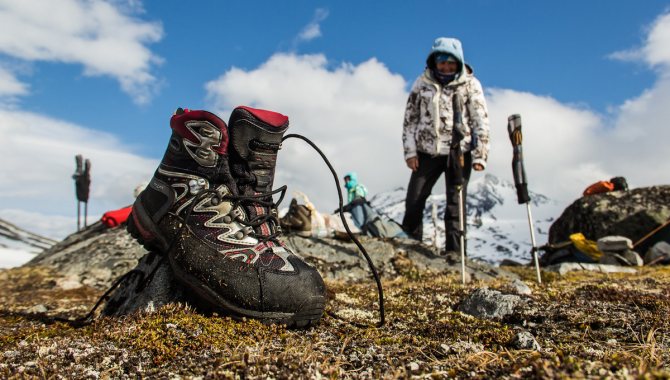
This method is practically the safest, but only works in warm, sunny weather. All you have to do is unlace your shoes, take out the insoles and wait. The main thing is to make sure that your shoes are on the sunny side, since even in good weather, in the shade your shoes will dry for an extremely long time.
If rain has never caught you on a hike, it means you haven't traveled much yet. The vagaries of the weather can become a serious problem if you have poorly chosen equipment. And even if it’s chosen well, it’s bad luck, it’s leaky. One way or another, knowing the rules for drying shoes in the field is useful for everyone. It will come in handy again and again.
Why are wet shoes dangerous?
Wet boots are not only unpleasant, but also cold. And if in the summer walking in wet shoes can, in the worst case, cause a runny nose, then in the fall and winter there is a high chance of developing cystitis or inflammation of the kidneys, or even frostbitten fingers. In addition, fungi actively multiply in damp conditions: if there is at least one tiny wound on the feet, the harmful microorganism will settle on the skin or, worse, penetrate under the nail. And then, instead of a new outing into nature, you will sit at home and think about how to treat onycholysis. Fungal infection of the foot is not a fatal disease, but it causes a lot of inconvenience. So let's dry it, friends! Dry your shoes thoroughly!
How to do this?
So, the boots got wet from the rain. If you just leave them near the tent overnight, hoping that they will dry out on their own, you will walk around in damp ones the next day. And this is unpleasant, inconvenient, and unhygienic. Therefore, the first thing you need to do is remove the insoles from your shoes. They are dried separately, without any tricks: simply by placing them in a dry, well-ventilated place. You'll have to tinker with the boots.
The simplest, but far from the best way, is to simply place them by the fire. Why exactly is this method bad? Firstly, after a rainstorm you may not be able to light a fire. Simply because you won’t find anything in the forest that can burn. Secondly, improperly drying shoes over a fire in nine out of ten cases leads to irreparable consequences: once good shoes turn into something wrinkled and completely disgusting in appearance. Wet leather hardens and cracks from the heat, suede warps, and synthetics melt. Taking this opportunity, I say hello to the geniuses who tried to dry shoes on pegs OVER the fire. Is it worth clarifying that it just burned out?..
How to quickly dry shoes without the danger of ruining them? It's not difficult at all. In one of the previous articles, I talked about how half a kilo of raw rice can save a phone that has fallen into the water. Rice perfectly absorbs moisture: if you place a cloth bag of cereal in each shoe in the evening, you will find them dry in the morning. The only significant disadvantage of this method is the extra item in the backpack. Accordingly, excess weight. After all, you are unlikely to eat rice for drying... unless you quickly run out of stew and biltong, and you don’t know how to catch crayfish and pick mushrooms.
But toilet paper is in any hiking backpack, regardless of the circumstances - and it also absorbs water perfectly. You unwind two pieces of about five meters, push one piece into each shoe, wait half an hour, pull out the completely wet paper and throw it away, repeat all over again. And so on until the shoes become dry. Or until the paper runs out.
And a few more words about how to quickly dry socks. At home you would use a hairdryer - but in the harsh conditions of the wild it will not help you in any way, even if by some miracle it ended up in your backpack. And so we put our socks on... our hands - and wave-wash-wash. Half an hour of intense passes is guaranteed to give the expected result.
And finally, some good advice: follow the weather forecasts and try not to go far from the benefits of civilization, since the weather forecasters have declared a thunderstorm. If an emergency arises (or, more likely, if the soul inexorably asks for adventure, ignoring the arguments of reason), look for a water-repellent shoe spray at a hardware store. Not perfect waterproofing, but much better than nothing. Even rag sneakers treated with it will be suitable for walking on wet grass. If you don’t find a spray, take at least some tape and a pack of garbage bags with you. You can put the bag on your leg, wrap it tightly with adhesive tape, and continue your journey in the rain without much discomfort... but not for long, the bag will keep your bags dry for a maximum of an hour or two. Plastic bags tend to tear. An important point: it is better to fit the bag not on top of the boot (it’s too slippery, and in this case the protection will leak in just a couple of minutes), but on top of the sock, inside the boot. Yes, your shoes will still get wet. And you still have to dry it. But you already know how it's done. And dry feet... believe me, dry feet after a serious thunderstorm that finds you in wild places is pure, unadulterated happiness.
There are no similar articles.
Stones
This method requires a lot of small stones. They are placed in a pot or tin can and heated over a fire. Having warmed the stones well (not to white heat!), pour them into the shoes. You can pre-wrap them with a scarf/towel/sock so as not to stain the shoes from the inside. Periodically, the stones need to be shaken so that the shoes are heated as evenly as possible.
This method allows you to dry even thoroughly wet boots in 20-60 minutes, although it requires care. It is not recommended to use this drying method for shoes with a thin synthetic lining and membrane, as hot stones can easily melt them.
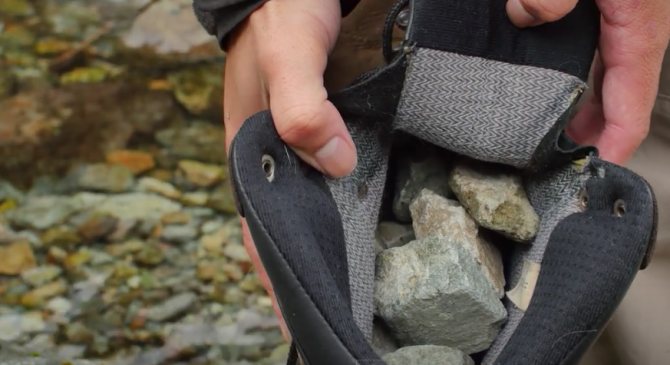
Drying with stones
If your shoes are made of durable natural materials, such as leather, you can try drying them with hot stones. By the way, this drying method is also suitable for insoles separately, but again, if it is not made of synthetics.
For this method you will have to do the following:
- Collect a lot of small pebbles, the amount of which should be enough for a pair of shoes.
- We put the stones in a pot or any other container and put it on the fire.
- When the stones are well heated, but not yet white-hot, they need to be quickly poured into the shoe.
- Now you need to waste no time and start actively and constantly shaking your shoes so that the stones roll freely inside. It is very important that such filler constantly moves, otherwise the interior finish of the shoe will deteriorate. This is especially true for models with a membrane or other synthetic materials.
When the stones have cooled completely, the procedure can be repeated until the moisture has completely evaporated. This method, when carried out correctly, is extremely effective, as it allows you to dry even completely wet shoes in just 10-20 minutes (Figure 4).
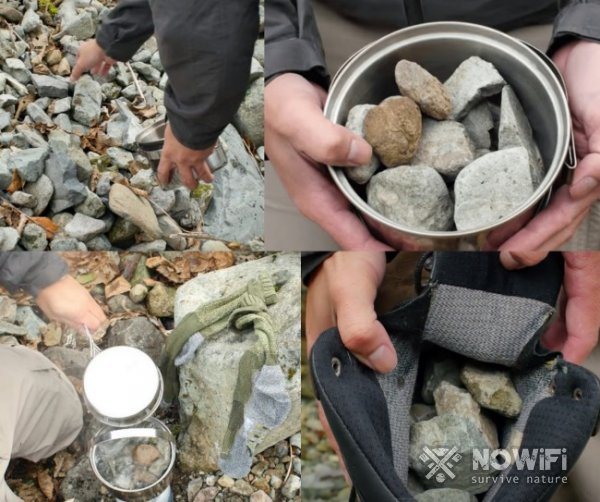
Figure 4. Drying with stones is considered a fast and effective method.
Despite the effectiveness of the method, experienced tourists do not recommend it to owners of shoes with a membrane. This fabric is very delicate and can be damaged by the intense heat of the stones.
Newspaper, paper and other available materials
Drying shoes with newspapers has been used everywhere for many years by more than one generation of people. Ordinary paper absorbs moisture very well and can make your shoes dry in a relatively short time. You just need to put enough paper in your shoes.
The disadvantage of this method for outdoor enthusiasts is that you need to carry more paper/newspapers with you. Yes, it weighs relatively little (maximum 500 - 1000 grams), however, during long hikes, every gram of weight counts, since the heavier the backpack, the more difficult it is to move, especially over rough terrain.
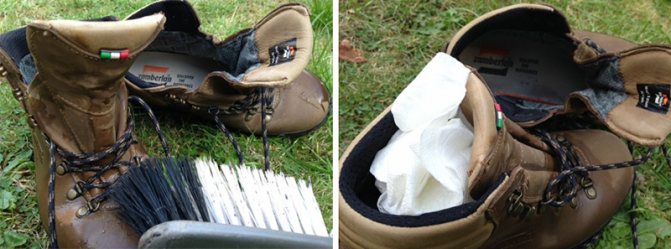
During a hike, the paper can be quite successfully replaced with some dry absorbent material, for example, leaves, grass or even moss. Yes, then you will have to carefully collect small debris from your shoes and shake them off thoroughly, but in some cases this is a more acceptable option than walking in wet shoes with the further possibility of “earning” a few calluses, foot fungus or even a cold.
Theploids and salt warmers
Thermoids and salt burners were developed specifically for tourism purposes. They can be safely held in your hands and used to warm your palms or other parts of the body. Due to its small size and wide range of applications, every experienced tourist takes with him on a trip at least one sample of the above-mentioned devices.
Theploids are most often small bags filled with a special composition. When opened, they react with oxygen and heat up noticeably, maintaining heat from several minutes to several hours (depending on the composition and dimensions). Modern thermoids are disposable.
Salt heating pads are a small silicone container filled with a special solution in which a small metal element floats. This same element starts the operation of the heating pad. You just need to bend the metal part a little, and then a chemical reaction will take place (the solution crystallizes, releasing a significant amount of heat). The main feature of salt heating pads is that they are reusable. After use, when the solution has already completely crystallized, the salt heating pad must be placed in boiling water for about 10 minutes, then it will return to its liquid state and will be ready for use again.
How to properly dry your shoes while hiking
Even the most expensive trekking boots with a high-quality membrane layer are not completely waterproof. In some particularly unfavorable weather conditions, even such shoes will get wet while hiking, let alone more modest models. Drying shoes while hiking is not as easy as it seems at first glance; especially beginners in tourism make serious mistakes.
The first thing that comes to mind for many inexperienced tourists is to dry their shoes while camping by the fire. You can, of course, place it on pegs driven in near the fire, but do this only if you don’t mind your shoes. In theory, you can try to place the boots at a sufficiently large distance from the fire so that they are not exposed to sparks and intense heat, but still get some warmth. However, drying your shoes while camping by the fire can easily damage them and negate all their thermoregulating properties, especially when it comes to membrane trekking models.
Every experienced hiker has his own safer drying method, but the manufacturers themselves recommend drying your shoes while hiking in the wind , after first removing the laces, insoles and turning out the tongue. In good clear weather, drying shoes is even easier, because under the warm rays of the sun they will dry very quickly.
To speed up the drying process, tourists practice their own methods , for example:
- If a rainstorm or other bad weather gets your boots wet, try to find handfuls of dry hay, grass or moss at a rest stop. Dry your hiking boots with these natural materials by simply filling your boots with them. Moss, grass or hay will absorb excess moisture. It is advisable to replace wet padding with dry padding from time to time to speed up the drying process.
- If you cannot find such natural materials, dry your shoes while hiking using the good old “newspaper” method, stuffing your shoes with crumpled sheets of newspaper. You can initially take the newspaper with you; there will always be a use for it when traveling, or you can purchase it somewhere along the way. When traveling, newspaper can also be replaced with toilet paper. Paper, like dry grass or moss, will absorb excess moisture.
- Household silica gel in the form of small translucent balls will help dry damp shoes. You've probably seen it in small bags in boxes of new shoes. Drying shoes while hiking using fabric bags filled with silica gel is very convenient. And although this is extra space and weight, this drying method will pay off. Instead of silica gel, drying bags can be filled with rice, which also perfectly absorbs moisture, but weighs more.
- When none of the above is at hand, dry your shoes while hiking with two pairs of warm socks. Put on dry ones and put on your shoes, and hang wet ones to dry. When this pair is dry, take off your shoes, take off the wet ones and hang them to dry, put the dried ones on, and put on your shoes again. The socks will gradually absorb excess moisture.
- It’s even faster to alternately dry your socks directly on yourself by the fire. To do this, put on a dry pair, stay in your boots for a while, alternately take off your feet and bring them to the fire, and when they warm up, put on your shoes again and wait until the socks are re-saturated with moisture. You definitely won’t burn your socks, because you will control the heat yourself.
- It is recommended to dry your shoes while hiking with heated sand or small stones. It is enough to pour them into a pot or an empty tin can, warm them over a fire, but do not heat them, pour them into unused socks and place them inside the boots. With this method, it is very important not to overheat the sand or pebbles so that they simply do not melt the material.
- You can dry your shoes while hiking in a seemingly hopeless situation using two plastic bottles with a capacity of 0.5 liters or less. It is enough to pour hot water into them and use them as a kind of heating pads, but as the water cools down you will have to add new water.
In many hiking situations, it is still not possible to completely dry your shoes, and in the morning you have to put on still damp shoes. For such situations, you can use salt insoles . They are heated by a harmless chemical reaction between a saline solution and a small metal element, retain heat for a long time and are reusable. However, this option is not suitable for light-footed tourists, for whom every extra gram is important.
You can dry your shoes while hiking in different situations, but it is still useful to always study the weather forecasts, and in particularly wet conditions, protect your feet with special hiking shoe covers or gaiters .
Silica gel
Far from the most popular method, however, it is nevertheless quite effective. Most people know this substance from the small paper bags with balls inside that are found in the box with new shoes. The purpose of this substance is to draw in excess moisture so that the shoes do not become damp during storage.
The advantage of silica gel is that it can be purchased almost anywhere and carried with you on hikes to dry not only shoes, but also any other equipment.
A couple of silica gel packets are best for drying slightly damp shoes, for example if you've just been walking around in your boots all day and your feet are very sweaty or you've been caught in a little rain. In other cases, when your shoes are wet through, a couple of bags of silica gel is definitely not enough.
A little advice
After drying, if you have left your shoes unattended in the field for even a short time, we recommend that you carefully check them, since most insects, snakes and rodents love to hide in such “confined spaces.”
Manufacturers' recommendations
In most cases, manufacturers advise not to dry shoes near an open fire or any other heat source. They recommend letting the boots dry in the wind without any aids. Thus, the shoes are guaranteed not to lose their beneficial properties and will remain intact longer, however, you will have to wait a very long time. Therefore, each tourist chooses for himself what is more important to him, dry shoes or the longest possible shelf life of his boots.
With the help of sun and wind
Another safe way to get your hiking boots in order is to dry them in the wind or sun. This method is good if you got your feet wet during the transition, and the sun came out at a rest stop (Figure 3).
The good thing about sun drying is that you don't have to constantly monitor the process. Natural heat will do all the work for you, quickly enough, and most importantly – absolutely safely. The only thing you have to watch is the direction of the rays. Over time, the sun will turn and your boots will be in the shade, so be sure to reposition them periodically.
If, in addition to the sun, a strong breeze arises, the process will be completed quickly, since strong air currents significantly accelerate the removal of moisture.
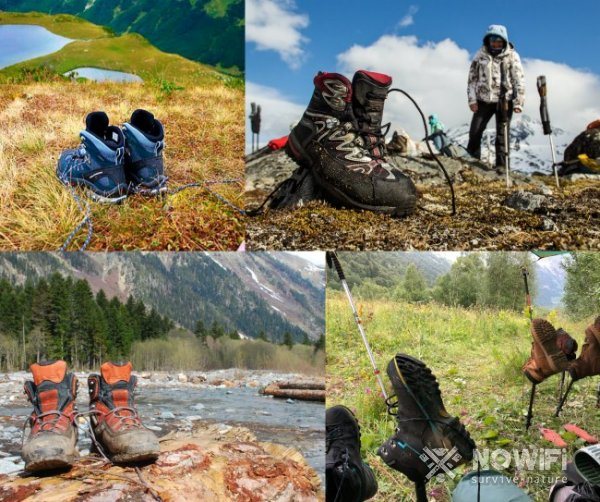
Figure 3. The easiest way to remove excess moisture is to expose wet boots to the sun.
It is important to remember that after such drying, the boots must be turned upside down and shaken vigorously. The fact is that all sorts of poisonous insects and snakes like to crawl under the shadow of the neck. To avoid any unpleasant surprises, it is better to check your shoes before putting them on.



